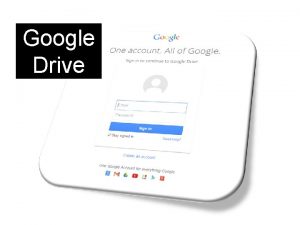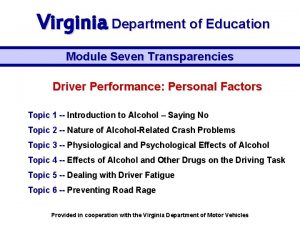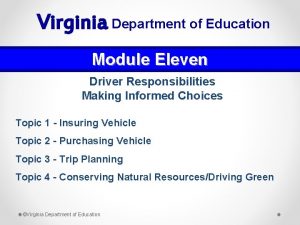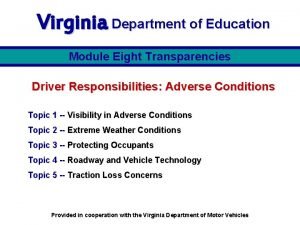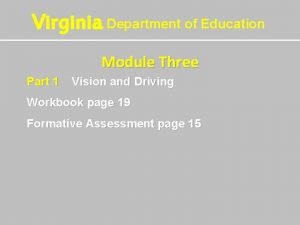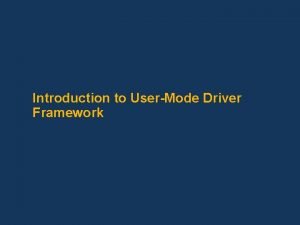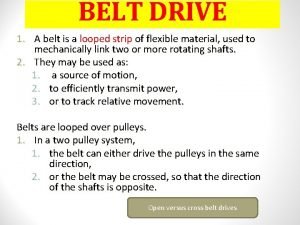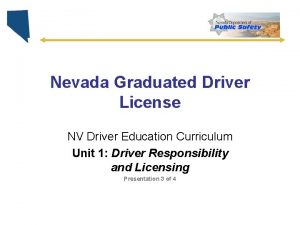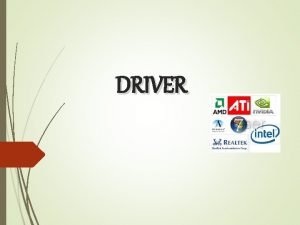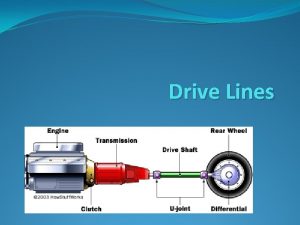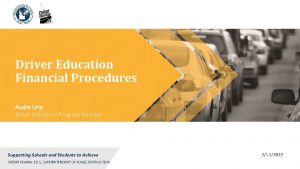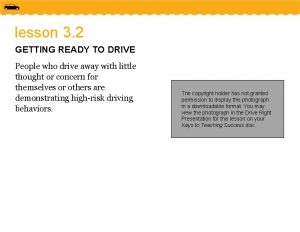Getting Ready to Drive NV Driver Education Curriculum
























- Slides: 24

Getting Ready to Drive NV Driver Education Curriculum Unit 3: The Driving Task Presentation 1 of 7

Pre-Drive Tasks • Check around the outside of the vehicle – – – Broken glass (windows, lights) Body damage Condition of tires Fluid leaks Direction of front tires (turned? ) Debris on the ground • Check for small children or pets

Pre-Driving Video See Car & Driver video Pre-Drive Checklist See ADTSEA video Pre-entry Checks http: //www. mpi. mb. ca/English/ dr_tips/Safe. Start. Practices. html http: //www. youtube. com/watch ? v=Skog. DHx. EI 8 Q&feature=ch annel http: //www. adtsea. org/videos/ Watch. aspx? Video. ID=3 d 2466 d a-818 d-4 acd-b 776355 a 37 cdfc 55 (0: 60) (2: 24) See 60 Second Driver video Safe Practices Before Start-Up (0: 40) NO sound Click on web address to access video clips *Suggest full screen viewing NOTE: Some on - Check access

Approaching from a Curb • When parked at the curb – Approach from the front of the car – Increase awareness of oncoming traffic – Approach with key in hand • Store valuable in trunk – Reduce risk of items sliding in car and distracting driver

Approaching in a Parking Lot • When parked in a parking lot – Approach from the rear of the car – Increase awareness of people and objects nearby – Approach with key in hand • Store valuable in trunk – Reduce risk of items sliding in car and distracting driver

Entering Your Vehicle • • Check traffic flow of approaching vehicles Unlock doors Enter as quickly as possible (to avoid conflicts) Check door swing Check passengers for safe entry Lock doors Place key in the ignition (do not start vehicle)

Driving Position Video See 60 Second Driver video Driver Position See Car & Driver video Proper Driving Position http: //www. mpi. mb. ca/English/ dr_tips/driver_position. html http: //www. youtube. com/watch ? v=84 wqdvx. IPw 0&NR=1&feat ure=fvwp (0: 60) (2: 37) Click on web address to access video clips *Suggest full screen viewing NOTE: Some on - Check access

Seating Position • Adjust the seat for comfort and control. • Sit with your back firmly against the seat. • Chin should be no lower than top of steering wheel. • Body at least 10 inches away from hub of steering wheel.

Head Restraints Designed to reduce whiplash injuries in a collision • Top of restraint at least as high as your eyes and as close as is comfortable to back of head

Whiplash Common in rear-end crashes

Head Rest Video See 60 Second Driver video Head Restraints http: //www. mpi. mb. ca/English/ dr_tips/Head. Restraints. html See My Ride video Seat and Head Rest Testing Explained http: //www. youtube. com/watch ? v=Kia. HHn. P 94 -4 (0: 60) (1: 59) @ my. Ride. com Originally from: Insurance Institute for Highway Safety Click on web address to access video clips *Suggest full screen viewing NOTE: Some on - Check access

Foot Pedals • Place right heel on floor in front of brake pedal • Pivot the foot to access the accelerator and brake – Accelerator Pedal A • speed/momentum – Brake Pedal B • slow/stop Knees should be slightly bent B A

Other Foot Pedals • Clutch Pedal 1 – Used in manual shift vehicles – Locate friction point for smooth operation • Dead Pedal 1 B 2 A 2 – Located left of floorboard, may be just a flat spot – For balance and stability for left foot and leg • Parking Brake (foot pedal or hand lever) – Emphasis on “parking” brake, rather than “emergency” brake

Steering Wheel • Seating at least 10 inches from wheel • Adjustment lever(s) • Able to place wrist on top of wheel (safe distance from air bag) • Place hands at 9 and 3 o’clock (air bag will deploy at 10, 2, and 6) • Elbows slightly bent

Mirrors • Inside Rearview Mirror – Position to show maximum view through rear window • Outside Side Mirrors – Adjust both left and right sides – Traditional setting or BGE setting

Setting Mirrors Video See 60 Second Driver video Blind Spots See Advance Auto Parts video Adjusting Mirrors See Daytime TV Show Mirror Adjustment http: //www. mpi. mb. ca/English/ dr_tips/Blind. Spots. html http: //www. advanceyourknowle dge. com/videos/mirrors. html http: //www. youtube. com/watch ? v=Kwz. UE 6 PHk 4 U TRADITIONAL setting BLIND-GLARE ELIMINATION (BGE) setting (0: 60) (1: 57) Click on web address to access video clips *Suggest full screen viewing NOTE: Some on - Check access

Mirror Settings Traditional Setting Blind-Glare Elimination (BGE) Should Check Needed Smaller blind spots

Traditional Mirror Setting • Adjust side mirrors so they show slightest amount of the side of the vehicle • See complete rear view window within 200 feet • Move head to expose blind spots

Cones outline the blind areas caused by traditional mirror settings Traditional side view mirror settings shows same view as rear view mirror TRADITIONAL SETTING RIGHT BLIND SPOT RIGHT SIDE VIEW LEFT SIDE VIEW TRADITIONAL SETTING LEFT BLIND SPOT REAR MIRROR VIEW

BGE Mirror Setting • Blindspot and Glare Elimination (BGE) developed in 1996 • No need to move head to look in blind spots • Adjust 15 degrees to the outside of car – Place head on driver side window, adjust mirror such that you barely see side of car – Move head to center of car, adjust passenger’s side mirror so that you can barely see side of car

The BGE enhanced side mirror settings (15 degrees to outside) eliminates right and left side mirror blind areas ENHANCED RIGHT SIDE MIRROR VIEW REAR MIRROR VIEW ENHANCED LEFT SIDE MIRROR VIEW Reference: Blindzone & Glare Elimination (BGE) Mirror Settings (G. Platzer, 1996)

Safety Belts Best protection against injury in a collision. • Adjust for best protection – Lap belt across boney pelvic area – Shoulder belt over collarbone and rib cage • Adjust should belt anchors on pillar • Tension relieving device adjustments • Check passengers

Seatbelt PSA Video See Public Service Announcement (PSA) Crash Affects without Seatbelt See Public Service Announcement (PSA) Rear Passenger Kills without Seatbelt See Public Service Announcement (PSA) Award Winning (with & without) Seatbelts http: //www. youtube. com/watch ? v=fi 5 -i. Vb 1 YKA http: //www. youtube. com/watch ? v=e 6 Qhmdk 4 VNs http: //www. youtube. com/watch ? v=UFls. Jc. Zjwzc (1: 01) Shopping, front passenger no belt, short distance crash affects (1: 12) Teen rear passenger kills others (0: 45) Heaven can Wait Click on web address to access video clips *Suggest full screen viewing NOTE: Some on - Check access

Safe Driving Tip Throw and Run If you are confronted by a carjacker, throw the keys in one direction while running in the opposite direction. If you have a key fob, push the panic button before throwing the keys. The carjacker is after your car, not after you.
 Stay ready so you don't have to get ready
Stay ready so you don't have to get ready Understanding google drive
Understanding google drive Https://slidetodoc.com
Https://slidetodoc.com Rit google docs
Rit google docs Getting ahead
Getting ahead Module 10 topic 4 drivers ed
Module 10 topic 4 drivers ed Module 7 topic 3 drivers ed
Module 7 topic 3 drivers ed Module 11 drivers ed virginia
Module 11 drivers ed virginia Module 8 topic 1 drivers ed
Module 8 topic 1 drivers ed Module 3 topic 4 basic maneuvering steering and braking
Module 3 topic 4 basic maneuvering steering and braking Yaw drivers ed
Yaw drivers ed Curriculum guide for driver education in virginia module 5
Curriculum guide for driver education in virginia module 5 Module 7 topic 1 distracted driving
Module 7 topic 1 distracted driving Bucketing getting ready to write answer key
Bucketing getting ready to write answer key Superteachers.com
Superteachers.com Getting ready to cook
Getting ready to cook Getting ready to cook
Getting ready to cook Getting ready
Getting ready 1984
1984 The verb estar page 107 answers
The verb estar page 107 answers If a student driver commits a traffic violation
If a student driver commits a traffic violation User-mode driver framework
User-mode driver framework Differentiate between belt drive and chain drive
Differentiate between belt drive and chain drive 1https://drive.google.com/drive/u/1
1https://drive.google.com/drive/u/1 Https drive google com
Https drive google com
